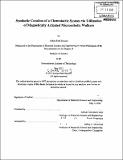Synthetic creation of a chemotactic system via utilization of magnetically actuated microrobotic walkers
Author(s)
Steimel, Joshua Paul
DownloadFull printable version (9.913Mb)
Other Contributors
Massachusetts Institute of Technology. Department of Materials Science and Engineering.
Advisor
Alfredo Alexander-Katz.
Terms of use
Metadata
Show full item recordAbstract
Chemotaxis is a fundamental biological process that plays an important role in disease, reproduction, and most biological functions. Here, we present a radically novel method to create the first synthetic chemotactic system which utilized magnetically actuated microrobotic walkers. The system used a rotating magnetic field that once actuated induced the magnetic beads to self-assemble into microrobots and walk on surfaces. The velocity of these microrobotic walkers could be modulated by the frequency and the number of beads that composed the walkers. The receptor-ligand pair of biotin-streptavidin was utilized due to the extremely strong binding affinity of the pair. The presence of free biotin binding sites on the surface was required to obtain chemotactic motion as these binding sites modulated walker velocity. The walkers moved faster in areas with a high density of binding sites and slower in areas with a low density of binding sites. To achieve chemotaxis, gradients in the density of binding sites were required. Gradients were created by placing a droplet of concentrated streptavidin on a biotynlated slide and letting the droplet evaporate. The Gaussian evaporation process created differentials in the density of binding sites. A series of continuous velocity measurements were conducted across the sample to map the walker velocity profile. The velocity profile illustrated regions with a high density of binding sites as well as a local minimum in the density of binding sites. The discrete motion of the beads was analyzed to understand how chemotactic directed motion could be achieved by breaking the symmetry of the system. Walkers in an area with a high density of binding sites experienced a significant amount of "sticking" followed by hinge-like motion, while walkers in a low density area exhibited virtually no "sticking" and tended to slip much more frequently. Walkers were then placed on a random walk path and chemotactic directed motion was observed as the walkers drifted towards regions with a high density of binding sites. The drift velocities that were extracted from the random walk path illustrated the discrepancy between the chemical gradients present in this synthetic chemotactic system. Keywords: biomimetic, chemotaxis, superparamagnetic microrobotic walkers, biotin, streptavidin, PEG, drift velocity, random walk.
Description
Thesis (S.B.)--Massachusetts Institute of Technology, Dept. of Materials Science and Engineering, 2012. Cataloged from PDF version of thesis. Includes bibliographical references (p. 55-58).
Date issued
2012Department
Massachusetts Institute of Technology. Department of Materials Science and EngineeringPublisher
Massachusetts Institute of Technology
Keywords
Materials Science and Engineering.